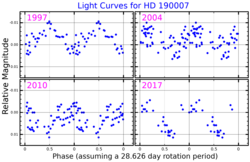| Observation data Epoch J2000 Equinox J2000 | |
|---|---|
| Constellation | Aquila[2] |
| Right ascension | 20h 02m 47.04569s[3] |
| Declination | +03° 19′ 34.2658″[3] |
| Apparent magnitude (V) | 7.46[1] |
| Characteristics | |
| Evolutionary stage | main sequence[4] |
| Spectral type | K5 V[5] |
| U−B color index | +1.09[6] |
| B−V color index | +1.11[6] |
| Variable type | BY Dra[7] |
| Astrometry | |
| Radial velocity (Rv) | −30.268±0.0013[8] km/s |
| Proper motion (μ) | RA: −90.383 mas/yr[3] Dec.: 119.430 mas/yr[3] |
| Parallax (π) | 78.6465 ± 0.0198 mas[3] |
| Distance | 41.47 ± 0.01 ly (12.715 ± 0.003 pc) |
| Absolute magnitude (MV) | 6.91[2] |
| Details | |
| Mass | 0.77±0.02[1] M☉ |
| Radius | 0.80[9] R☉ |
| Luminosity | 0.24[9] L☉ |
| Surface gravity (log g) | 4.50[10] cgs |
| Temperature | 4,610±20[1] K |
| Metallicity [Fe/H] | 0.16[10] dex |
| Rotation | 28.626±0.046 d[1] |
| Other designations | |
| Database references | |
| SIMBAD | data |
| ARICNS | data |
HD 190007, also known as Gliese 775, is a star with a close orbiting exoplanet in the constellation of Aquila. Parallax measurements by Gaia put the star at a distance of 41.5 light-years (12.7 parsecs) away from the Sun. It is drifting closer with a radial velocity of −30.3 km/s,[8] and is predicted to come within 11.8 light-years in 375,000 years.[12] The star has an absolute magnitude of 6.91,[2] but at its present distance the apparent visual magnitude is 7.46,[1] which is too faint to be viewed with the naked eye.
The variability of the brightness of HD 190007 was discovered by George Wesley Lockwood et al. from data taken during a photometry program at Lowell Observatory carried out from 1984 through 1995.[13] It was given its variable star designation, V1654 Aquilae, in 1997.[14]
The spectrum of HD 190007 matches a K-type main-sequence star with a stellar classification of K5 V.[5] It is classified as a BY Draconis variable, showing a moderate level of magnetic activity in its chromosphere[4] with a suspected activity cycle lasting 13.7 years.[15] The star displays a mild enhancement of metals and its age is uncertain. It has 77%[1] of the mass of the Sun, 80% of the Sun's radius,[9] and is spinning with a rotation period of 28.6 days.[1] HD 190007 is radiating 24%[9] of the luminosity of the Sun from its photosphere at an effective temperature of 4,610 K.[1]
- ^ a b c d e f g h i Cite error: The named reference
Burt2020was invoked but never defined (see the help page). - ^ a b c Cite error: The named reference
xhipwas invoked but never defined (see the help page). - ^ a b c d Cite error: The named reference
GaiaDR3was invoked but never defined (see the help page). - ^ a b Cite error: The named reference
Stalport2023was invoked but never defined (see the help page). - ^ a b Cite error: The named reference
kirkpatrick1991was invoked but never defined (see the help page). - ^ a b Cite error: The named reference
EgUBVwas invoked but never defined (see the help page). - ^ Cite error: The named reference
gcvswas invoked but never defined (see the help page). - ^ a b Cite error: The named reference
Soubiran_et_al_2018was invoked but never defined (see the help page). - ^ a b c d Cite error: The named reference
Chandlerwas invoked but never defined (see the help page). - ^ a b Cite error: The named reference
Misheninawas invoked but never defined (see the help page). - ^ Cite error: The named reference
SIMBADwas invoked but never defined (see the help page). - ^ Cite error: The named reference
Bailer-Jones_et_al_2018was invoked but never defined (see the help page). - ^ Cite error: The named reference
Lockwoodwas invoked but never defined (see the help page). - ^ Cite error: The named reference
Kazarovetswas invoked but never defined (see the help page). - ^ Cite error: The named reference
Obridko_et_al_2022was invoked but never defined (see the help page).
